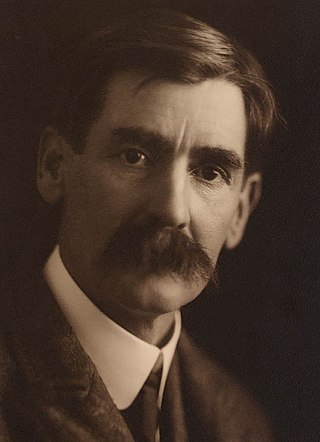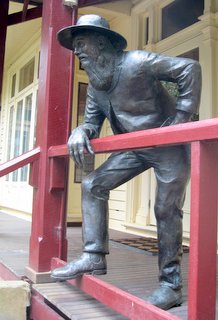
Andrew Barton "Banjo" Paterson, was an Australian bush poet, journalist and author. He wrote many ballads and poems about Australian life, focusing particularly on the rural and outback areas, including the district around Binalong, New South Wales, where he spent much of his childhood. Paterson's more notable poems include "Clancy of the Overflow" (1889), "The Man from Snowy River" (1890) and "Waltzing Matilda" (1895), regarded widely as Australia's unofficial national anthem.

Henry Archibald Hertzberg Lawson was an Australian writer and bush poet. Along with his contemporary Banjo Paterson, Lawson is among the best-known Australian poets and fiction writers of the colonial period and is often called Australia's "greatest short story writer".

"The Man From Ironbark" is a poem by Australian bush poet Banjo Paterson. It is written in the iambic heptameter.
"Bell-Birds" is a poem by Australian writer Henry Kendall that was first published in The Sydney Morning Herald on 25 November 1867.
The Women of the West is a poem by Australian poet George Essex Evans. It was first published in The Argus newspaper on 7 September 1901, and later in the poet's poetry collection The Secret Key and Other Verses (1906).
"The Last of His Tribe" is a poem by Australian writer Henry Kendall that was first published in The Sydney Morning Herald on 27 September 1864, under the title "Woonoona: The Last of His Tribe".
Andy's Gone With Cattle is a poem by Australian writer and poet Henry Lawson. It was first published in The Australian Town & Country Journal on 13 October 1888.

The Teams is a poem by Australian writer and poet Henry Lawson. It was first published in the Australian Town and Country Journal on 21 December 1889. It was later published in the poet's poetry collection In the Days When the World Was Wide and Other Verses in 1896.

In the Days When the World Was Wide and Other Verses (1896) is the first collection of poems by Australian poet and author Henry Lawson. It was released in hardback by Angus and Robertson in 1896, and features the poet's widely anthologised poems "The Free Selector's Daughter", "Andy's Gone with Cattle", "Middleton's Rouseabout" and the best of Lawson's contributions to The Bulletin Debate, a famous dispute in The Bulletin magazine from 1892-93 between Lawson and Banjo Paterson.
Where the Pelican Builds is a poem by Australian poet Mary Hannay Foott. It was first published in The Bulletin magazine on 12 March 1881, and later in the poet's collection Where the Pelican Builds and Other Poems (1885).
"The Never-Never Country" (1901) is a poem by Australian poet Henry Lawson. It is also known by the title "The Never-Never Land".
"Faces in the Street" (1888) is a poem by Australian poet Henry Lawson.
"The Song of Old Joe Swallow" (1890) is a poem by Australian poet Henry Lawson.
"The Old Bush Road" (1892) (aka is a poem by Australian poet Jennings Carmichael.
"The Buried Chief" (1886) is a poem by Australian poet Henry Parkes.
"Song of the Shingle Splitters" (1874) is a poem by Australian poet Henry Kendall.
"The Crane is My Neighbour" (1938) is a poem by Australian poet John Shaw Neilson.
"How M'Dougal Topped The Score" (1898) is a poem by Australian poet Thos. E. Spencer.
"The Fire at Ross's Farm" (1890) is a poem by Australian poet Henry Lawson.
"A Bushman's Song" (1892) is a poem by Australian poet A. B. Paterson.




